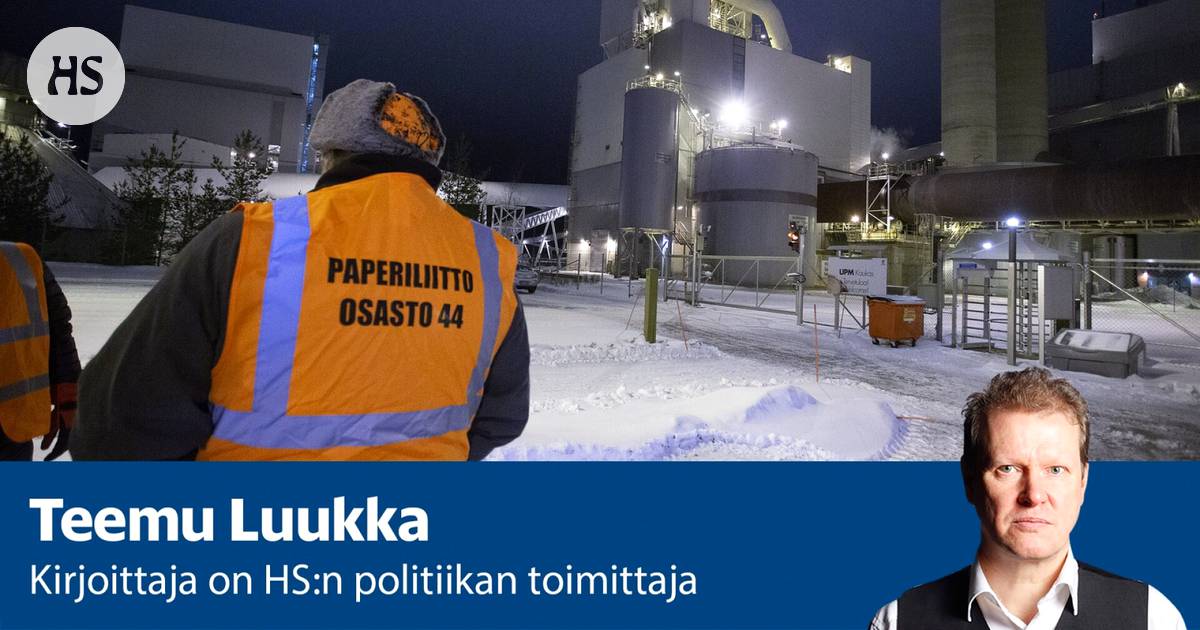The 112-day strike, which ended on Friday, was the longest in Finland in more than 70 years. UPM’s struggle looks confusing, writes HS policy journalist Teemu Luukka in his analysis.
22.4. 20:43
On Friday Finland’s longest strike ended in more than 70 years, when the Paper Association and the forestry company UPM approved a mediator Leo to Finland conciliation proposal.
The strike lasted 112 days.
Docent who studied the history of the trade union movement Tapio Bergholmin according to only the plumbers’ strike in 1951 has been longer than the exceptional labor struggle now experienced.
Inderes analyst Antti Viljakainen estimates that the strike will reduce UPM’s operating profit by approximately EUR 2-3 million per day. The strike could therefore have cost UPM more than EUR 300 million.
Viljakainen emphasizes that it is still difficult to say the exact number. UPM has not assessed the impact of the strike on the public.
Read more: The months-long strike at UPM’s mills is coming to an end, and the parties accept the settlement proposal
Which In this case, the strike was very costly for UPM, partly because pulp sales were very profitable during the strike.
Three of UPM’s four pulp mills are located in Finland. The Lappeenranta biofuel plant would also have spilled a considerable amount of money during the strike.
UPM will report the negative effects of the strike as small and the positive effects as large as it can.
UPM achieved some of its key goals in the agreement reached on Friday.
Above all, it received contracts that were separate and somewhat more flexible than before for all five of its industries.
With the agreement, the company switched from seasonal pay to hourly pay. According to the company, the salary will be paid in more detail in the future, but the cost impact on the company is likely to be pretty much the same as before.
From the length of the strike, it could be concluded that salaries in particular are the main item of expenditure for UPM’s operations.
This is not the case, but salaries are estimated to account for about 10 to 15 percent of the company’s costs.
The raw materials are a much larger batch, but when plant closures are considered and international comparisons are made, all batches are important.
UPM tried to get print paper drivers in particular to work 100-150 hours more a year without a pay rise. That’s where the company failed.
Working hours will be extended by about 30 hours a year in paper mills, but the extra time will be paid a normal salary.
The working hours of paper unionists are shorter than the average for employees. An employer can hardly say that he has made a back profit and the fate of an employee cannot be considered unreasonable if working time rises, for example, from 34.5 hours to about 35 hours a week.
The company promised to pay wages to employees during the contract period if the company closes paper mills during the period.
UPM also wanted the opportunity to outsource its operations, but there was no change in outsourcing. In practice, the company will still not be able to outsource its operations without the approval of the main shop steward.
For the Paper Union the strike cost about 20 million euros in strike grants. In addition, employees lost their earnings. There were other losses to society from the strike: revenues of subcontractors and forest owners and state tax revenues decreased.
The Paper Association won in that its position as a party to the negotiations was not weakened and the earnings of the employees were not weakened.
Usually strikes start because wage earners want more pay or other benefits.
That was not the case now. The paper allies are demanding exactly the same pay rise as has usually been paid this year and last.
Now the claimant was the employer: it wanted those famous job-specific flexibilities.
The strike came because employees saw that UPM wanted to weaken the bargaining power of the trade union movement. The Paper Association feared and did not blame UPM for wanting to negotiate salaries and other benefits with the employee, not through a strong union.
“The industrial action did not only affect UPM’s paper union members, but more broadly the trade union movement: during the strike, the paper unionists defended the right to organize,” the paper union wrote in a post-settlement press release.
UPM: n The battle looks confusing because two other large forest companies, Stora Enso and Metsä Group, were able to negotiate their own agreements with the Paper Association without strikes. Metsä Group also has industry-specific agreements, which were concluded without strikes.
UPM’s efforts to have its own contracts for each industry are reasonable, but it is difficult to see that the strike losses will be repaid in time.
UPM: n the CEO Jussi Pesosta has been regarded as the leader in the exact euro that has elevated UPM to success.
However, the strike took so long that UPM’s customers may have wondered, which is why Pesonen was willing to risk the company’s reputation and huge profits in a labor dispute that would result in an agreement that would not be radically different from its competitors.
A strike could damage your reputation. The company has also been able to lose market share, but hardly significantly and permanently.
UPM is a very successful company with a thick balance sheet and can afford to keep shareholders happy with decent dividends even if earnings deteriorate due to the strike.
UPM’s President and CEO Jussi Pesonen and UPM’s Chairman of the Board Björn Wahlroosilla it is customary to emphasize the interests of shareholders in all the activities of the company.
Butter however, to ask whether this struggle was solely in the interests of shareholders.
In the eyes of an outsider, it seems that this time there was also a real dose of a long pent-up feeling and a desire to discipline and defeat the trade union movement.
Long industrial action is always felt for a long time in the workplace.
While it will certainly be nice for employees to return to work and get a decent salary again, UPM has also been hit as an employer.
Trade unionists in particular will remember UPM’s crusade for a long time.
Nor did the fight improve the image of the forest companies’ employers at all, but the Paper Association’s reputation as a contractor was hardly strengthened in any way.
There has been talk of a company-specific agreement in Finland for a long time, and that is what UPM wanted. The end result was a grimace of company-specific agreement.
It would seem that such a sensible-sounding agreement would have been achieved with less money.
#analysis #strike #UPMs #mills #mockery #local #contracts

/https://content.production.cdn.art19.com/images/73/08/d7/63/7308d763-42d3-4c06-89aa-f25a1eb886a9/08f4d96a249522638b7a5b30defa992a000fef395af04983c58078b0faed8a)







